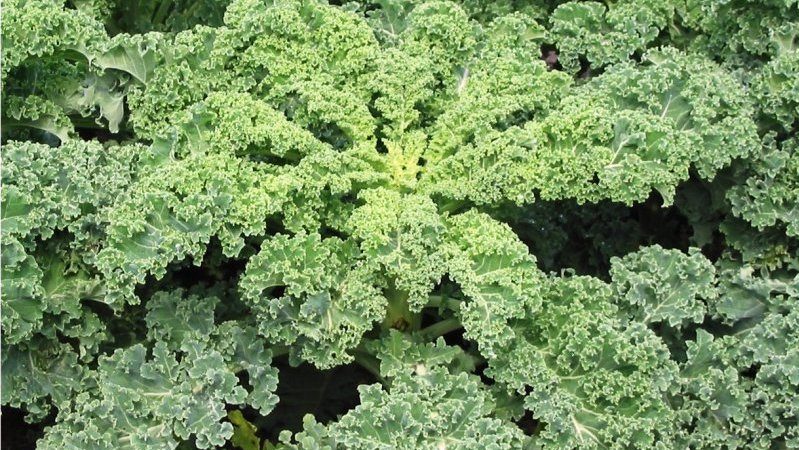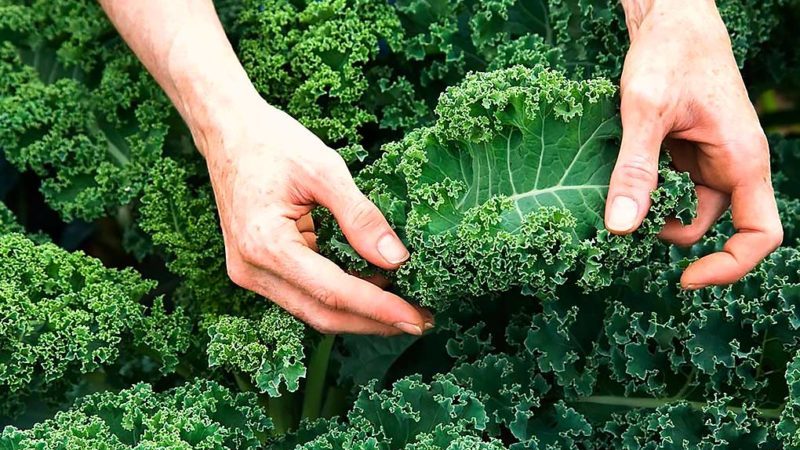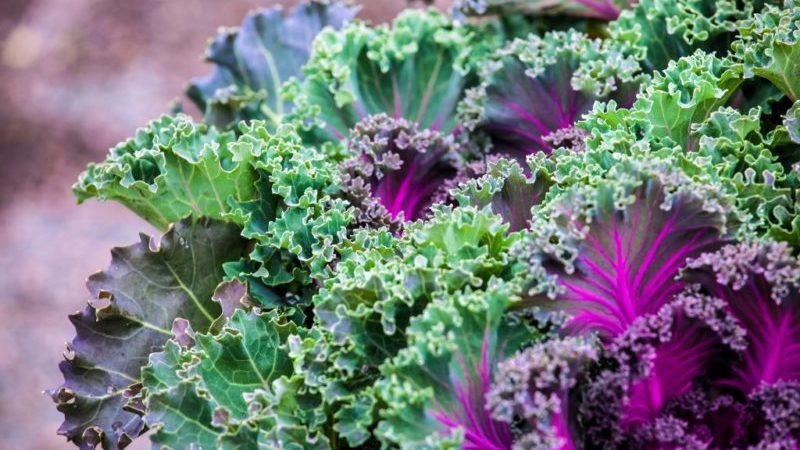Growing kale
Kale is a plant from the Cruciferous family that is used in cooking and landscaping. This variety of garden cabbage does not form a head, its leaves are terry, and the stem is rigid. All parts of the vegetable are used for food, except for the stalk, as it is too hard and bitter. To get a rich harvest of kale, it is important to choose the right place for planting, water and feed the crop on time.
Growing kale
Curly cabbage, or kale, is grown by seed and seedling methods. Whatever method is used, it is important to follow the breeding and care rules.

How to grow seedlings
In order not to damage cabbage seedlings when picking and transferring to a permanent place, the seeds are immediately planted in separate pots or cassette boxes. Sowing dates directly depend on the region. It begins 45–55 days before the planned planting of plants in the ground.
Preparing soil and seeds
First of all, prepare the seed material:
- Immerse the seeds in water heated to +45...+50°C for 20 minutes.
- Place in cold water for 5 minutes.
- Soak for 20 minutes in a 1% solution of potassium permanganate.
- Place the seeds in a damp cloth for 2-3 days for germination and put them in a warm place.
- After the sprouts appear, the seed material is planted in pre-prepared containers with soil.
Proper sowing
To grow cabbage seedlings, use ready-made biosoil or make the mixture yourself. To do this, combine sand, soil from the site, humus and peat in proportions of 0.5: 1: 1: 2.As a fertilizer and for disinfection, add 3 tbsp to 1 bucket of soil. l. ash.
The seeds are buried 1.5 cm into the soil, sprinkled with earth and lightly patted with hands. The container is covered with cling film or glass and put in a warm place until germination.
Important! To prevent the crops from dying, the shelter is removed daily for 1-2 hours for ventilation.
To obtain healthy seedlings, its daylight hours should be 10–12 hours. To do this, turn on additional lighting. The air temperature is maintained around +16°C.
Landing in the ground
The ideal place for kale is a slightly shaded, sunny, flat area. Favorable neighbors and predecessors for culture:
- peas;
- garlic;
- potato;
- cucumbers;
- sage;
- beans;
- spinach;
- celery;
- dill.
The plant should not be planted after other cruciferous vegetables, beets and radishes.
Read also:
The best time for preparations: when to salt cabbage in November and how to do it correctly
Simple, quick and very tasty recipes for pickling cabbage for the winter
Soil preparation
Collard greens grown in acidic soil are bitter and have small leaves. To normalize acidity, 500 g of dolomite flour per 1 m² is added to the soil. The suitable soil pH for the crop is 5.5–6.8.
The area is dug up, immersing the shovel on a full bayonet. In autumn, 3-4 kg of humus per 1 m² is added to the soil, in spring - complex mineral fertilizers (100 g per 1 m²). Typically used are “Fitosporin”, “Gera for cabbage”, “Kaliphos N” and “Agricola”. Then small holes are made at a distance of 30–40 cm from each other. Leave 50–60 cm between rows.
Landing
Kale seedlings are ready to be transplanted into open ground 4–6 weeks after sowing. Plants 8–10 cm high should have 4 full leaves.
Seedlings are planted after the threat of frost has passed and the air has warmed to +5°C. Algorithm of actions:
- Make a hole of such depth that the root system, together with the lump of earth from the cup, fits completely into it.
- Add a mixture of wood ash and clay in proportions 1:1.
- Immerse the seedling in the hole along with the seed leaves.
- Sprinkle with soil and compact lightly.
- Pour over warm water.
In order for cabbage to take root better, the beds with it are covered with greenhouse film or special covering material. It is removed after 5–7 days.
Caring for Kale Cabbage
Caring for this crop is not much different from growing other varieties of cabbage. It includes timely watering, fertilizing, treatment against diseases and pests, and mulching the soil.

Watering
Kale prefers moderately moist soil. On cloudy days it is watered once every 5 days, on hot days - 2-3 times a week. To prevent the soil from hardening, it is loosened periodically (1-2 times a week).
After the plants reach 20 cm in height, they are hilled. This helps strengthen the root system and retain moisture.
Mulching
Experienced gardeners advise immediately after planting to cover the soil around the seedlings with straw, hay or sawdust. Mulching will protect the soil from drying out, root rot and wild weed growth.
Top dressing

Kale, like other garden crops, is fertilized with organic and mineral mixtures. It is important to observe the timing and dosage of applying the compositions:
- for the first time, feed the kale 2 weeks after planting, use a urea solution (1 tbsp per 10 liters of water);
- 2-3 weeks after the first feeding, water the cabbage with mullein solution (1 kg per 10 liters of water);
- Fertilizers are applied for the last time after another 3-4 weeks; nitrophoska is most often used (1 tbsp per 10 liters of water).
The consumption of any type of fertilizer is the same - 1 liter per 1 bush. Fertilize after evening watering.
Experienced vegetable growers feed kale with a mixture of chicken manure and grass. This composition is used instead of mullein solution. It is prepared as follows:
- A 100 liter barrel is filled with water.
- Place 10 kg of fresh grass in it.
- Add 2-3 kg of dry chicken manure.
- When foam appears, the solution is mixed well every day. This will speed up fermentation.
- After 1-3 weeks, when the composition stops foaming, it will be completely ready for use.
For feeding, the solution is diluted with warm water in proportions 1:1. Water the cabbage at the root: take 1 liter for 1 bush.
Removing wilted leaves
Damaged leaves kale has cabbage - bait for various harmful insects. Therefore, if even slight signs of wilting appear on them, they are immediately removed.
This is interesting:
Ornamental cabbage: photo, planting, growing and care
High-yielding hybrid of Vestri cabbage f1 with excellent taste
Conclusion
Kale is a garden crop known for its high content of protein, iron and vitamins B, A, K and PP. The right location on the site, the composition of the soil, timely watering and fertilizing with nutrients will help you get a rich harvest.